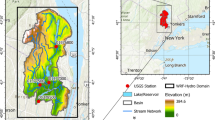Abstract
This paper presents two object models with corresponding simulation algorithms, which aim to condition well data correctly while still converging in reasonable time. The first model is devoted to fluvial channels and the second one is mainly intended for smaller objects. To verify the conditioning, a method for validating well conditioning algorithms for object models is given. The purpose is to determine the extent to which the well conditioning introduces a bias in the models. To do this, we check that the double expectation of a parameter conditioned to wells is equal to the unconditional expectation. This method is applied to two different object models. Both the conditioning algorithms presented here give good results using this test.
Similar content being viewed by others
References
Deutsch CV, Wang L (1996) Quantifying object-based stochastic modeling of fluvial reservoirs. Math Geol 28(7):857–880
Hastings WK (1970) Monte Carlo sampling methods using Markov chains and their applications. Biometrika 57(1):97–109
Holden L, Hauge R, Skare Ø, Skorstad A (1998) Modelling of fluvial reservoirs with object models. Math Geol 30(5):473–496
Lantéjoul C (1997) Iterative algorithms for conditional simulations. In: Baafi EY, Schofield NA (eds) Geostatistics Wollongong ’96, proceedings ‘5th international geostatistics congress’, Wollongong, Australia, 1996. Kluwer Academic, Dordrecht, pp 27–40
Lia O, Tjelmeland H, Kjellesvik L (1997) Modeling of facies architecture by marked point models. In: Baafi EY, Schofield NA (eds) Geostatistics Wollongong ’96, proceedings ‘5th international geostatistics congress’, Wollongong, Australia, 1996. Kluwer Academic, Dordrecht, pp 386–397
Skorstad A, Hauge R, Holden L (1999) Well conditioning in a fluvial reservoir model. Math Geol 31(7):857–872
Syversveen AR, Omre H (1997) Marked point models for facies units conditioned on well data. In: Baafi EY, Schofield NA (eds) Geostatistics Wollongong ’96, proceedings ‘5th international geostatistics congress’, Wollongong, Australia, 1996. Kluwer Academic, Dordrecht, pp 415–423
Viseur S, Shtuka A, Mallet JL (1998) New fast, stochastic, boolean simulation of fluvial deposits. In: 1998 annual technical conference and exhibition, society of petroleum engineers, New Orleans, LA, USA
Author information
Authors and Affiliations
Corresponding author
Rights and permissions
About this article
Cite this article
Hauge, R., Holden, L. & Syversveen, A.R. Well Conditioning in Object Models. Math Geol 39, 383–398 (2007). https://doi.org/10.1007/s11004-007-9102-z
Received:
Accepted:
Published:
Issue Date:
DOI: https://doi.org/10.1007/s11004-007-9102-z




